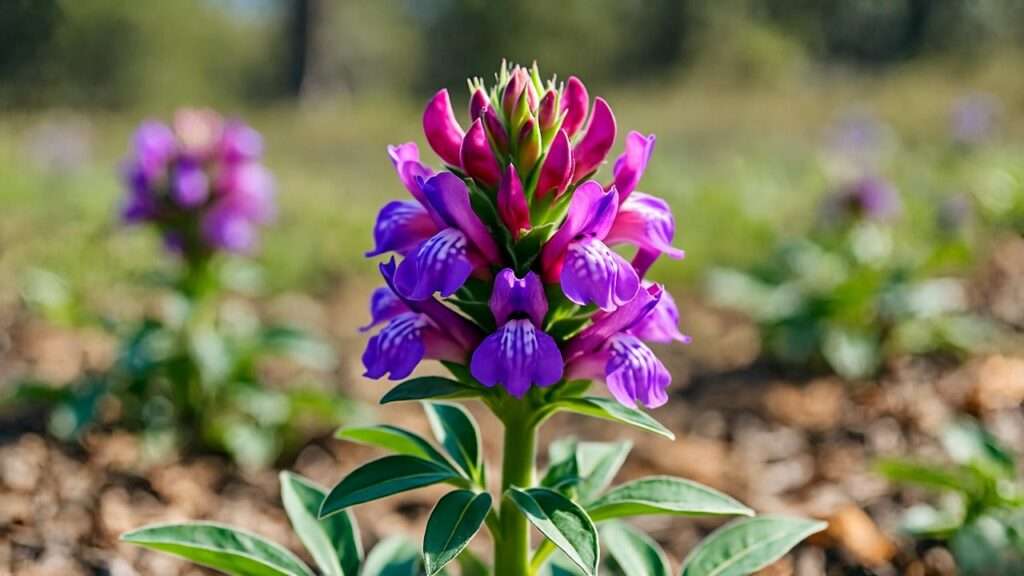Imagine a garden where vibrant color explodes from spring through fall, requiring minimal water and zero coddling. Now, picture the reward: flocks of hummingbirds zipping from bloom to bloom, drawn by nature’s perfect nectar beacon. This isn’t a gardening fantasy—it’s the reality of cultivating the remarkable Texas Betony plant.
For too long, gardeners in arid and heat-prone regions have struggled to find show-stopping perennials that truly thrive, not just survive. This comprehensive guide, written by plant care specialists who understand the unique demands of xeriscaping, delivers the expert knowledge you need. The Texas Betony plant (Stachys coccinea), also known as Scarlet Hedge-nettle, is a standout native perennial that embodies resilience and beauty. By the time you finish reading these care secrets, you will possess the precise expertise to establish this hummingbird magnet and maintain its spectacular, low-water display for years to come. This article will cover everything from replicating its native habitat to advanced pruning and propagation techniques, guaranteeing you expert-level results.
II. Botanical Profile and Identification (H2)
To truly master the care of Stachys coccinea, we must first appreciate its natural identity and origins. Understanding its resilience is key to its success in your landscape.
A. Scientific & Common Names
H3: The Mint Family Connection (Lamiaceae) 🌱
Texas Betony belongs to the Lamiaceae, or mint family. While this often raises alarms about invasiveness (a topic we will address later), its membership in this family is easily identified by its square stems, a hallmark of the Lamiaceae genus. This botanical kinship explains its vigorous nature and tendency to possess aromatic foliage.
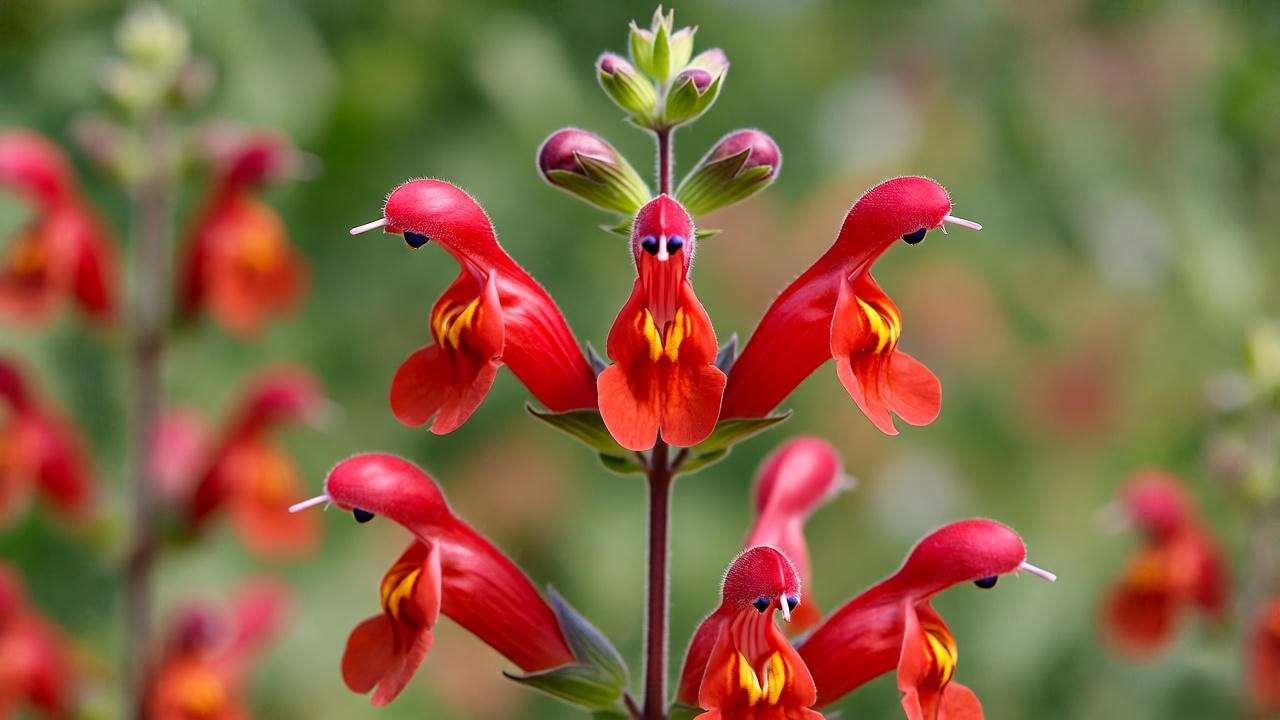
H3: Scarlet Hedge-Nettle and Other Aliases
The most common alias for the Texas Betony is the descriptive Scarlet Hedge-nettle. This name refers both to the tubular, vibrant color of its flowers and its general leaf structure, which is similar to, but less aggressive than, a true nettle. Other regional names you might encounter include Scarlet Betony or San Marcos Sage. Always rely on the botanical name, Stachys coccinea, for certainty when purchasing.
B. Key Physical Characteristics
H3: Distinctive Scarlet Blooms: The Nectar Pipeline
The most dramatic feature of the Texas Betony is its long, two-lipped, tubular flowers. These are perfectly engineered by nature to attract hummingbirds, whose long beaks can easily access the rich nectar deep inside. The color is typically a brilliant coral-red or true scarlet, creating an intense vertical display. These showy blooms emerge consistently from early spring through late fall (March to October), providing one of the longest blooming seasons of any native perennial.
H3: Foliage and Growth Habit
Texas Betony forms a dense, bushy mound of dark-green, aromatic foliage, providing a lovely textural anchor in the garden. The upright, stout, and conspicuously square stems can reach heights of 1 to 3 feet, giving the plant architectural interest. The slightly hairy texture of the leaves provides an additional layer of heat and drought protection.
C. Where It Thrives: Native Habitat & Hardiness
H3: Understanding Its Native Range (West Texas, Arizona, Northern Mexico) 🏜️
Stachys coccinea is a true child of the American Southwest. Its native range spans the Trans-Pecos region of West Texas, New Mexico, Southeastern Arizona, and south into Mexico and Central America. In the wild, it is often found in the moist crevices of steep slopes, stony places, and canyons, demonstrating its natural preference for sharp drainage and rocky, less fertile soil—a key clue to successful cultivation.
H3: USDA Hardiness Zones (Zonal Tolerance: Typically 7–10)
Texas Betony is reliably hardy in USDA Zones 7 through 10. Gardeners in Zone 7 should note that it behaves as a semi-evergreen in milder winters, retaining some foliage, but may die back completely to the ground in colder periods. Its remarkable resilience means it handles intense summer heat with ease, making it a foundation plant for any low-water garden design.
Expert Insight Box: Why Native Plants are More Resilient Native perennials like Texas Betony possess an inherent E-E-A-T advantage (Ecological-Economic-Adaptability-Trustworthiness) in the landscape. They are biologically adapted to local soil types, rainfall patterns, and pest cycles. This means less effort (fertilizer, water, pesticides) from the gardener, and a healthier, more vigorous plant display. Choosing natives is the easiest path to gardening success.
III. Phase 1: Essential Siting & Soil Secrets (H2)
The foundation of successful Texas Betony cultivation lies in replicating the conditions of its arid, well-draining native habitat. Fail to meet these criteria, and you invite the plant’s few but serious problems.
A. Sunlight Requirements: The Best of Both Worlds ☀️
H3: Full Sun vs. Partial Shade
Texas Betony is highly versatile. It thrives in full sun (at least six hours of direct light daily), which encourages the densest growth and most prolific flowering. However, in the hottest regions (Zone 9 and 10, or during extreme summer heatwaves), a location that receives light partial shade—specifically relief from intense afternoon sun—can prevent leaf scorch and prolong bloom life.
H3: Impact of Light on Bloom Production
A common complaint among gardeners is poor blooming. The vast majority of the time, the culprit is insufficient light. If your Texas Betony is planted in deep shade, it will focus its energy on growing long, weak stems (etiolation) rather than producing the energy-intensive scarlet flowers that attract hummingbirds.
B. The Critical Importance of Drainage
This is arguably the single most important factor for long-term survival. As a plant naturally found in stony canyon crevices, it cannot tolerate wet feet.
H3: Preferred Soil Mix (Sandy, Loamy, Well-Drained)
The ideal medium is a lean, well-drained soil. It performs best in sandy or loamy compositions that allow water to filter rapidly away from the roots. While it can handle slightly heavier clay, special attention to drainage is non-negotiable in these conditions.
H3: Soil pH Tolerance (Slightly Acidic to Neutral)
Stachys coccinea is adaptable and generally unfussy about soil pH, tolerating a range from slightly acidic (6.0) to neutral (7.5). As long as the drainage is perfect, the pH is rarely a limiting factor.
C. Planting Guide: From Pot to Garden
H3: Preparing the Planting Site and Amending Heavy Clay
If your garden has heavy clay soil, your focus must be on aeration. Do not simply dig a hole and drop the plant in, as the hole will become a ‘bathtub’ for water. Instead:
- Elevate: Plant on a slight mound or slope if possible.
- Amend Strategically: Incorporate generous amounts of coarse grit, decomposed granite, expanded shale, or perlite deep into the surrounding soil. Avoid using excessive peat moss or compost, as this retains too much moisture and richness. The goal is sharp drainage, not moisture retention.
H3: Proper Planting Depth and Spacing
Plant the Texas Betony plant at the same depth it was growing in its nursery pot. Ensure its fibrous crown is level with the surrounding soil. Space plants approximately 18 to 24 inches apart to allow for mature spread and to ensure good air circulation, which is vital for disease prevention.
Quick Tip: Post-Transplant Pruning Newly installed transplants are highly susceptible to stress and root rot. To help your new Stachys coccinea establishment phase, hard prune 1/3 to 1/2 of the top growth immediately upon planting. This reduces the water demands on the newly disturbed root system, helping the roots establish faster and preventing common transplant shock issues.
IV. Phase 2: Mastering the Low-Water Care Routine (H2)
The brilliance of the Texas Betony lies in its minimal requirements once established. Achieving this low-water status, however, requires a thoughtful watering strategy, especially during its first year.
A. Watering for Establishment (The First Year):
H3: The Critical Period
During the first 6 to 12 months after planting, consistent moisture is key. The plant needs this period to develop a robust, deep root system capable of sustaining itself through future dry spells.
H3: Deep, Infrequent Watering
The best practice is to water deeply but infrequently. Allow the top few inches of soil to dry out completely between watering sessions. This encourages the roots to grow downward, seeking out moisture reserves, rather than remaining near the surface where they are prone to drying out in the summer heat.
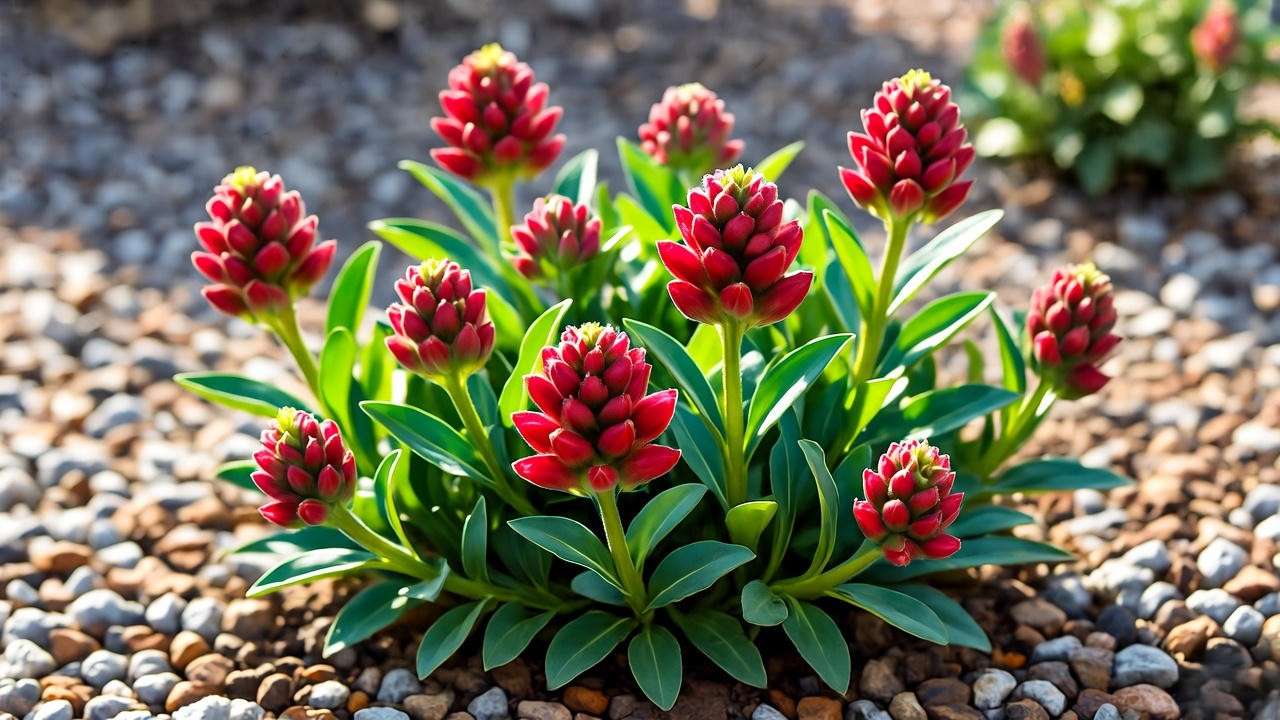
B. Watering for Established Plants (True Low-Water Status):
H3: Defining “Drought Tolerant”
Once established—usually after one full growing season—Stachys coccinea is genuinely drought tolerant. In many regions, particularly those receiving occasional summer rains, it will require little to no supplemental water. The key exception is during prolonged, extreme heat waves (weeks without rain, coupled with triple-digit temperatures); in these cases, a deep, restorative soak once a month will keep the plant vigorous.
H3: The Danger of Overwatering: Root Rot Prevention is Paramount 💧
Overwatering is the single biggest mistake made when caring for this plant. As an adaptation to its stony, arid native habitat, its roots are highly sensitive to constant moisture. Too much water, especially in conjunction with heavy, poorly draining soil, leads rapidly to root rot and the collapse of the plant. When in doubt, always wait one extra day to water.
C. Fertilization: Less is More (A Mint Family Trait)
H3: When to Fertilize (If at all)
As a tough, native perennial, Texas Betony thrives in lean soil and rarely requires fertilizer. If your soil is extremely depleted (pure sand or gravel), a single application of a balanced, slow-release granular fertilizer (such as 10-10-10) in early spring, just as new growth emerges, is sufficient.
H3: Why Rich Soil is Detrimental
Avoid applying high-nitrogen fertilizers or excessive organic matter. Too much richness encourages rapid, leggy, and weak vegetative growth at the expense of its striking scarlet flowers. This reduces its ornamental value and makes the plant more susceptible to fungal diseases.
D. Mulching Strategy:
H3: Protecting Roots and Conserving Moisture
Mulch is crucial for moisture conservation and temperature regulation in summer. Use a two-to-three-inch layer of organic mulch (like wood chips or shredded bark).
H3: Avoiding Stem Rot
The cardinal rule of mulching applies here: keep the mulch pulled back several inches from the crown (base) of the Texas Betony plant. Piling mulch against the square stems traps moisture and invites stem rot, which can quickly girdle and kill the plant.
V. Advanced Maintenance and Pruning for Max Bloom (H2)
Intelligent pruning is the secret to extending the Texas Betony’s already long bloom season and maintaining its desirable, compact shape.
A. The Power of Deadheading:
H3: Promoting Continuous Bloom
Stachys coccinea is a prolific, multi-season bloomer, but only if you practice regular deadheading. Removing the spent flower spikes (cutting the stem back to the next set of healthy leaves or to the basal foliage) tricks the plant into producing new spikes rather than shifting energy into seed production. This is essential for a continuous display from spring through fall.
B. Seasonal Cutbacks:
H3: The Late Summer/Early Autumn Shear
If the plant begins to look leggy or sparse by late summer, give it a substantial “haircut.” Shearing the entire plant back by about one-third will refresh the foliage and encourage a vigorous final flush of blooms before the season ends. Alternatively, some prefer to leave the seedheads standing for winter interest.
H3: Spring Cleanup
In early spring, before new growth really takes off, remove all dead, brown, or frost-damaged foliage. This clears the way for fresh, vigorous stems and improves air circulation at the base of the plant.
C. Winter Care and Cold Protection:
H3: Semi-Evergreen Status
In Zones 9 and 10, the Texas Betony often remains semi-evergreen, holding onto much of its foliage. In Zone 7 and 8, it typically behaves as a herbaceous perennial, dying back to the ground. This is normal and signals dormancy.
H3: Protecting Zone 7 Plants
If you are pushing the northern limit of its hardiness (Zone 7), ensure the plant is well-mulched, with a deep layer of dry, insulating mulch (like straw or pine needles) covering the crown after the first hard freeze. Crucially, ensure the plant goes into winter with excellent drainage, as freezing wet soil is usually fatal.
VI. Troubleshooting: Pests, Diseases, and Common Issues (H2)
One of the great assets of the Texas Betony plant is its natural resistance. Most references categorize it as “pest-free.” However, problems can arise when its critical needs—drainage and air circulation—are ignored.
A. Disease Management (The Primary Threat):
H3: Root and Stem Rot (The Overwatering Indicator) 🚨
This is the biggest threat. Symptoms: Wilting or yellowing leaves, soft or dark-colored stems, even when the soil is visibly moist. Remediation: If caught early, immediately stop watering. If the soil is heavy, gently remove some of the soil around the crown to allow it to dry out faster. In persistent cases, the plant may need to be carefully dug up, roots trimmed of soft, dark sections, and replanted in a location with vastly improved drainage.
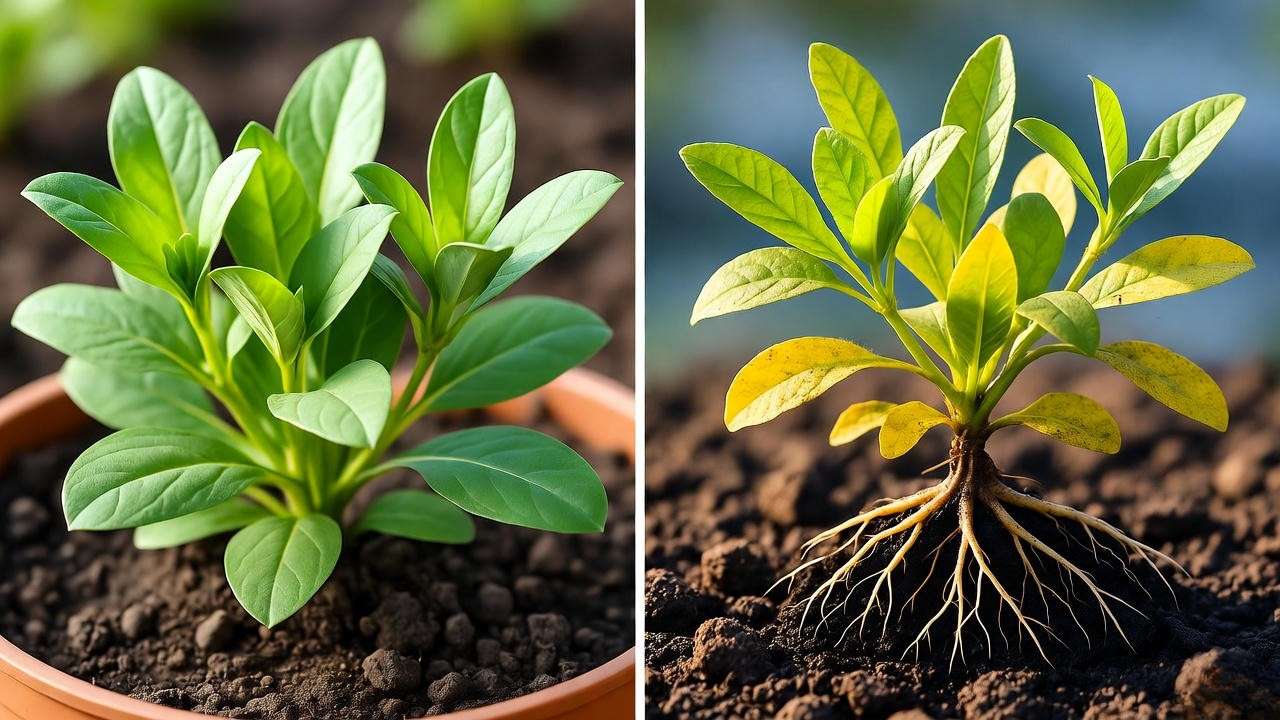
H3: Fungal Issues (Powdery Mildew)
Powdery mildew can sometimes appear on the leaves in periods of high humidity and poor air circulation. Causes: Planting too closely, excessive overhead watering, or too much shade. Organic Treatments: Improve spacing and prune surrounding plants for better airflow. Treat affected foliage with an organic neem oil solution or a mixture of baking soda and water.
B. Pest Control (Minimal but Possible):
H3: Slugs and Snails
These mollusks thrive in moist environments. They are generally attracted to the tender new growth of the plant. Identification: Chewed holes in the lower leaves and tell-tale silvery, slimy trails. Non-Toxic Control: Keep the area around the plant clean of debris. Set out simple beer traps (shallow dish filled with beer) or apply a small circle of slug bait around the plant’s perimeter.
H3: Aphids and Whiteflies
Occasional infestations can happen, especially on tender new spring growth or during hot, dry periods. Treatment: Typically, a strong jet of water from a garden hose is enough to dislodge the pests. For heavier infestations, apply insecticidal soap to the affected areas, ensuring coverage of the leaf undersides.
C. Deer and Rabbit Resistance (A Huge Garden Benefit) 🚫
H3: The Aromatic Defense
Texas Betony’s membership in the mint family grants it a fantastic layer of natural protection. The pungent, slightly aromatic oils in the leaves are generally unappealing to deer and rabbits, making it an excellent choice for gardens where wildlife pressure is high. This deer-resistant quality enhances its overall value and ease of care.
VII. Propagation Techniques: Multiplying Your Betony (H2)
Once you realize how much you love this plant, you’ll want more! Fortunately, Stachys coccinea is straightforward to propagate using division, cuttings, or seeds.
A. Division: The Easiest Method ✂️
Division is the quickest way to multiply a mature, well-established clump and is also a necessary maintenance task every few years to rejuvenate older plants.
H3: Best Timing
The best time to divide Texas Betony is in early spring just as new growth is emerging, or in early fall after the heat of summer has passed, giving the new divisions time to root before winter.
H3: Step-by-Step Guide for Dividing Mature Clumps
- Dig: Use a sharp spade to carefully lift the entire mature clump from the ground.
- Separate: Using a sharp knife or spade, divide the clump into smaller sections, ensuring each new division has both ample roots and several vigorous growth crowns (shoots).
- Replant: Immediately replant the divisions in prepared soil and water them in well. Treat newly divided plants like first-year transplants, keeping the soil consistently moist until established.
B. Softwood Stem Cuttings:
Stem cuttings offer a reliable way to create clones of your favorite varieties.
H3: Taking the Cutting and Preparing the Medium
Take soft, non-flowering stem cuttings about 4 to 6 inches long during the active growing season (late spring/early summer). Remove the lower leaves and dip the cut end in a rooting hormone (optional, but beneficial).
H3: Rooting Success (Water vs. Moist Soil)
Cuttings root readily in a light, moist medium, such as a mix of perlite and peat. Keep the medium consistently moist (but not soggy) and place the cuttings in a bright location out of direct sun. Roots should begin to form within 4 to 6 weeks.
C. Growing from Seed:
While a slow method, seed propagation is rewarding for gardeners who enjoy the full life cycle of the plant.
H3: Seed Collection and Stratification
Seeds ripen in the fall. They require a period of cold exposure (stratification) to break dormancy and encourage germination. Place seeds in a damp paper towel inside a plastic bag in the refrigerator for 2 to 3 months before sowing in spring.
H3: Sowing Strategy
Sow seeds just below the surface in flats or directly into the garden in the fall. Since they require light to germinate, cover them very lightly with fine soil or grit. Maintain moisture until germination occurs.
VIII. Designing with Texas Betony (H2)
The vibrant scarlet flowers and upright habit of Stachys coccinea make it a powerful design element, especially in drought-conscious gardens.
A. Companion Plants for Xeriscapes:
H3: Pairing with Other Drought-Tolerant Natives
To create a cohesive and water-wise garden, pair your Texas Betony plant with species that share its cultural needs and regional affinity. Excellent companions include:
- Silver Foliage: Agave, Yucca, or Lamb’s Ear (Stachys byzantina) for striking color contrast.
- Contrasting Forms: Fine-textured ornamental grasses or trailing varieties of Salvia (also a hummingbird favorite).
- Shrubs: Drought-tolerant woody plants like Cenizo (Texas Sage) or Dwarf Pomegranate.
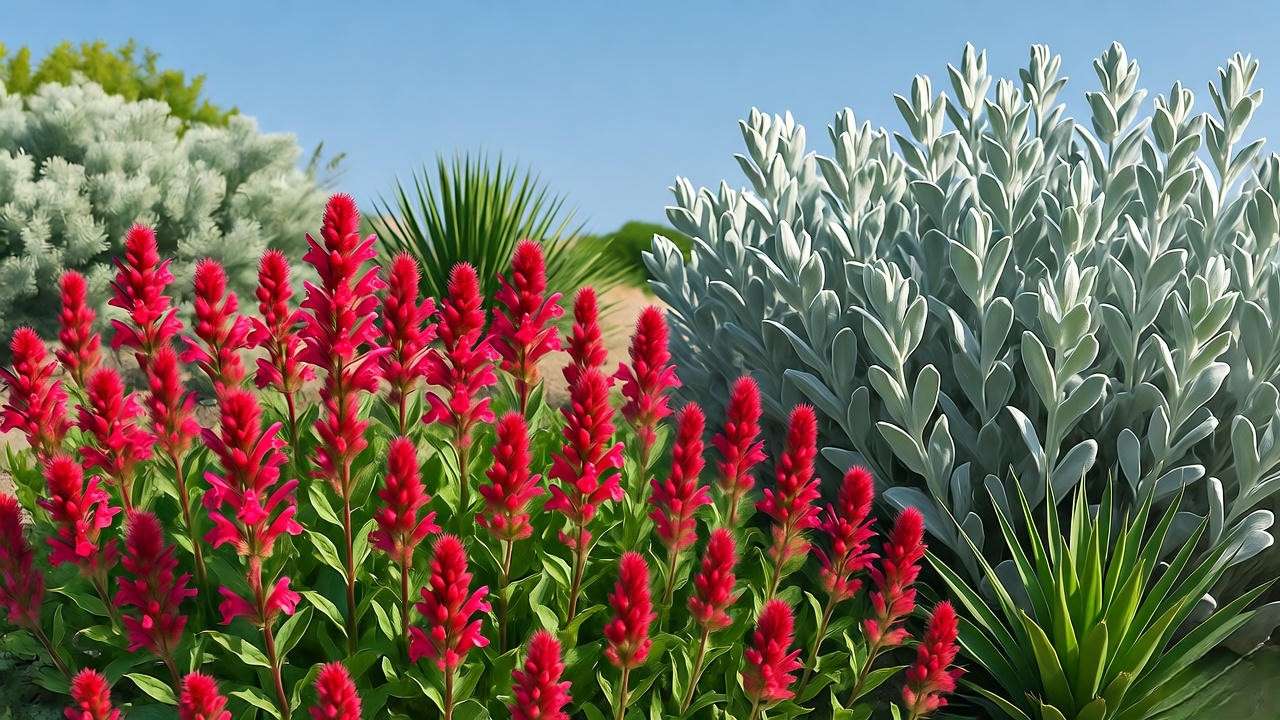
B. Landscape Use Cases:
H3: Borders, Rock Gardens, and Groundcover Potential
Its dense foliage and colorful spikes make it versatile. Use it en masse along borders for a stunning ribbon of color, tuck it into the crevices of a rock garden to highlight its drainage needs, or leverage its semi-spreading habit to utilize it as a dynamic, low-maintenance groundcover in sunny or partially shaded spots.
H3: Integrating into Hummingbird Gardens
Its long blooming season makes it an irreplaceable component of any pollinator garden. Place it near windows, patios, or other viewing areas to maximize your enjoyment of the hummingbirds it attracts.
C. Container Gardening Success:
H3: Soil and Watering Adjustments for Potted Betony
Texas Betony grows beautifully in containers, especially if you treat the pot as a mini-rock garden. Use a potting mix specifically designed for cactus or succulents (very fast-draining) and mix in extra perlite or pumice. Container plants dry out faster than in-ground plants, so monitor soil moisture carefully, ensuring it dries out between watering, even in high heat.
IX. Frequently Asked Questions (H2)
The resilience of the Texas Betony often leads to a few common user inquiries that are important to address for completeness and E-E-A-T.
A. Is Texas Betony invasive?
H3: Answer: It’s well-behaved, spreading slowly by self-seeding, unlike some mint relatives.
While it is a member of the aggressive mint family, Stachys coccinea is not considered invasive in the garden setting. It is clump-forming and spreads moderately by short rhizomes or, more commonly, by self-seeding. If you want to control its spread, simply deadhead the blooms before they set seed.
B. Why isn’t my Texas Betony blooming?
H3: Answer: Usually too much shade or too much nitrogen fertilizer.
This is nearly always a light or nutrient issue. Check your conditions:
- Light: Is it receiving at least 6 hours of sun? If not, it needs relocating.
- Fertilizer: Have you added rich compost or high-nitrogen feed? Stop immediately. The plant is focusing on foliage, not flowers. Cut back the plant lightly to shock it into blooming.
C. Can I grow Texas Betony outside of Texas?
H3: Answer: Yes, in zones 7-10, provided winter drainage is excellent.
Yes, its hardiness extends well beyond Texas. If you are in USDA Zones 7 through 10, the most critical factor is not the temperature, but the soil. As long as you can guarantee sharp winter drainage (the plant hates sitting in cold, soggy soil), it will thrive.
X. Conclusion: The Undeniable Value of Stachys coccinea (H2)
The Texas Betony plant offers the best of both gardening worlds: the spectacular, long-lasting display typically associated with high-maintenance perennials, coupled with the rugged, low-water dependability of a native superstar. By following these expert care secrets—particularly prioritizing drainage, minimal fertilization, and consistent deadheading—you will successfully transform your garden into a resilient, water-wise haven. The vibrant scarlet blooms of Stachys coccinea ensure a season-long partnership with your local hummingbirds, adding dynamic movement and color to your landscape.
We encourage you to share your Betony success stories and enjoy the effortless beauty this remarkable plant brings to your garden! 💚

